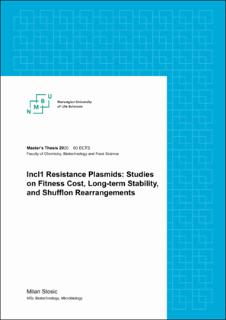| dc.contributor.advisor | Knut, Rudi | |
| dc.contributor.advisor | Sunde, Marianne | |
| dc.contributor.author | Milan, Stosic | |
| dc.date.accessioned | 2020-10-16T10:59:41Z | |
| dc.date.available | 2020-10-16T10:59:41Z | |
| dc.date.issued | 2020 | |
| dc.identifier.uri | https://hdl.handle.net/11250/2683317 | |
| dc.description.abstract | The plasmid-mediated spread of antibiotic resistance genes is considered a major dissemination pathway between related and non-related bacteria. IncI1 plasmids have been found to be carriers of a wide variety of bacterial accessory genes that code for different abilities such as antibiotic resistance, virulence, utilization of different nutrients, and heavy metal tolerance. Without selection for these abilities, the plasmid could impose a burden to its host, thereby reducing its fitness. One of the aims of the thesis was to examine to what extent IncI1 plasmids carrying ESBL/AmpC genes inflict a fitness cost to their new hosts under conditions not selecting for the plasmid encoded traits. The new hosts for the selected plasmids were three Quinolone Resistant E. coli (QREC) strains with three different STs, and one Avian Pathogenic E. coli (APEC) strain. During single strain growth assay, the carrying capacity of most of QREC transconjugants was significantly lower than carrying capacity of their respective plasmid-free recipients, while APEC transconjugants exhibited no such difference compared to their plasmid-free recipient. The competitive growth experiment of selected transconjugant/plasmid-free recipient pairs revealed reduced competitive fitness of transconjugants. However, the magnitude of the competitive fitness reduction appeared to be both plasmid and host dependent.
A previous study revealed that IncI1 plasmids were stable during competitive growth of plasmid-containing cells with their plasmid-free counterpart even when the initial number of plasmid-containing cells was 100x lower. This study obtained comparable results. However, instead of a gradual increase of the number of plasmids throughout the experiment, an instantaneous increase of the number of plasmids in all competing pairs after only 24 hours was detected, further indicating a high rate of plasmid transfer between plasmid-free and plasmid-containing cells. However, the strain chosen to examine the stability of selected plasmids was a laboratory DH5α rifR E. coli strain with an exceptional ability to accept and maintain plasmids. Future long-term stability studies of IncI1 plasmids in wildtype E. coli strains rather than laboratory model strain are needed to examine the actual stability of the IncI1 plasmids.
Finally, this study also attempted to quantitatively analyse rearrangements of insertion-sequence interrupted shufflons and uninterrupted shufflon during single strain growth. An insertion sequence (ISEcp1) harbouring blaCTX-M-1 was a part of the B shufflon segment. To further examine whether the host of plasmids with the interrupted shufflon affects its rearrangement, plasmids were grown in their original host or in the QREC 2773(ST162) strain. Results confirmed that the interrupted shufflons generated fewer variants compared to the uninterrupted shuflon, although both shufflon types exhibited a predominance of certain plasmid-specific variants, regardless of the host or sampling time point. Additionally, shufflon variants with a deletion of one or two segments were detected in both shufflon types. The predominant truncated variants of the interrupted shufflon suffered from the deletion of the B segment alone or B and C segments together. This finding implicates that Rci, site-specific recombinase, was challenged when inverting a 3kbp longer segment that often resulted in segment deletion. Finally, the most abundant segment found to complete the pilV ORF was the A segment as previously reported. As long-read sequencing was found suitable for the structural shufflon rearrangement analysis, future studies should focus on uncovering whether the same pattern of shufflon rearrangements observed during single strain growth would also be observed during mating. | en_US |
| dc.description.abstract | Den plasmid-medierte spredningen av antibiotikaresistens gener ansees som en viktig spredningsvei mellom beslektede og ikke-beslektede bakterier. IncI1-plasmider er funnet til å være bærere av et bredt utvalg av bakterielle tilbehørgener som koder for forskjellige evner som antibiotikaresistens, virulens, utnyttelse av forskjellige næringsstoffer, og tungmetalltoleranse. Uten påført seleksjon for disse evnene, kan plasmidet påføre verten en belastning, og dermed redusere dens fitness. Denne avhandlingen hadde som mål å undersøke i hvilken grad IncI1-plasmider, bærere av ESBL / AmpC-gener, påvirker fitness av sine nye verter under forhold som ikke påfører seleksjon for plasmidkodede egenskaper. De nye vertene for de valgte plasmidene var tre Qunilone Resistant E. coli (QREC) stammer med tre forskjellige ST-er, og en Avian Pathogenic E. coli (APEC) stamme. Under singel-stamme vekstanalyse var bæreevnen til de fleste av QREC-transkonjuganter statistisk betydelig lavere enn bæreevnen til deres respektive plasmidfrie resipientstammer, mens APEC-transkonjuganter ikke utviste en statistisk betydelig forskjell sammenlignet med deres plasmidfrie resipientstamme. Konkurrerende veksteksperiment av utvalgte transkonjugant/resipient par utviste redusert konkurranseevne av transkonjuganter. Imidlertid ser omfanget på fitness-reduksjon ut til å være både plasmid- og vertsavhengig. | en_US |
| dc.language.iso | eng | en_US |
| dc.publisher | Norwegian University of Life Sciences, Ås | en_US |
| dc.rights | Attribution-NonCommercial-NoDerivatives 4.0 Internasjonal | * |
| dc.rights.uri | http://creativecommons.org/licenses/by-nc-nd/4.0/deed.no | * |
| dc.subject | IncI1 plasmids | en_US |
| dc.subject | Conjugation | en_US |
| dc.subject | Shufflon rearrangement | en_US |
| dc.subject | Plasmid fitness cost | en_US |
| dc.subject | Plasmid stability | en_US |
| dc.title | IncI1 resistance plasmids : studies on fitness cost, long-term stability, and shufflon rearrangements | en_US |
| dc.type | Master thesis | en_US |
| dc.subject.nsi | VDP::Technology: 500::Biotechnology: 590 | en_US |
| dc.subject.nsi | VDP::Mathematics and natural science: 400::Basic biosciences: 470::General microbiology: 472 | en_US |
| dc.subject.nsi | VDP::Mathematics and natural science: 400::Basic biosciences: 470::Molecular biology: 473 | en_US |
| dc.subject.nsi | VDP::Mathematics and natural science: 400::Basic biosciences: 470::Bioinformatics: 475 | en_US |
| dc.source.pagenumber | 95 | en_US |
| dc.description.localcode | M-BIOTEK | en_US |

